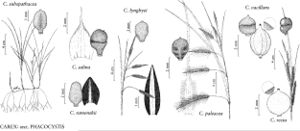Carex recta
in W. J. Hooker, Fl. Bor.-Amer. 2: 219, plate 222. 1839.
Plants not cespitose. Culms obtusely or acutely angled, 25–80 cm, glabrous. Leaves: basal sheaths redbrown or brown; sheaths of proximal leaves smooth, fronts lacking spots and veins, apex U-shaped; blades usually amphistomic, 2.5–5 mm wide, papillose or glabrous. Inflorescences: peduncle of proximal spike 0.6–2 cm; proximal bract equal to or longer than inflorescence, 3–5 mm wide. Spikes erect or the proximal pendent; proximal 3–5 spikes pistillate, 3–5.5 cm × 2–6 mm, base cuneate or attenuate; terminal 1–3 staminate. Pistillate scales brown to reddish-brown, 2.8–5.5 × 0.9–1.4 mm (including awn), narrower than perigynia, midvein reaching apex, 1/3–1/2 the width of the scale, apex acuminate, aristate, awn glabrous or scabrous. Perigynia ascending, pale-brown, 0–4-veined on each face, somewhat inflated, loosely enclosing achenes, ellipsoid, 1.9–3.1 × 1.2–2 mm, dull, base with stipe to 0.3 mm, apex acute, short-papillose; beak slightly conic to cylindric, 0.2–0.3 × 0.2–0.3 mm, entire. Achenes strongly constricted on 1 face, sometimes on 1 margins, apex rounded to truncate, sometimes glossy; style base strongly bent, rarely straight. 2n = 73, 75, 76.
Phenology: Fruiting Jul–Aug.
Habitat: Saline, brackish shores, swales, intertidal marshes, river estuaries
Elevation: 0–10 m
Distribution

St. Pierre and Miquelon, Man., Nfld. and Labr., N.S., Ont., P.E.I., Que., Maine, Mass., N.H., Europe
Discussion
Carex recta is a common, stabilized hybrid or backcross between C. aquatilis and C. paleacea (J. Cayouette and P. Morisset 1985, 1986; L. A. Standley 1990), which does not occur outside of the common range of the two parents. Plants of the northernmost latitudes tend to have darker scales. Previous reports from Maine (mostly), New Hampshire, and Massachusetts of C. recta, C. salina, and C. salina var. cuspidata are based on plants of C. vacillans or hybrids of C. paleacea.
The voucher of the chromosome number report of 2n = ca. 70 (R. J. Moore and J. A. Calder 1964) for Carex recta from Prince Edward Island is C. paleacea × C. stricta. Backcrosses of C. recta with its parents, known as C. ×grantii Ar. Bennett, are frequent in Newfoundland and Labrador, northern Ontario, eastern to northwestern Quebec, and northwestern Europe. Reports from elsewhere were based on misidentifications of C. paleacea × C. recta. Other accepted hybrids of C. recta are crosses of C. recta with C. salina and C. subspathacea. A specimen intermediate between C. recta and C. stricta is known from northwestern Quebec. Other reports of C. recta hybrids are misidentifications: C. miliaris × C. recta (= C. ×nubens E. Lepage) and C. recta × C. aquatilis subsp. minor are C. aquatilis × C. recta; Carex nigra × C. recta (= C. ×super-goodenoughii (Kükenthal) E. Lepage) is C. vacillans.
Selected References
None.
Lower Taxa
"shortened" is not a number.No values specified.
